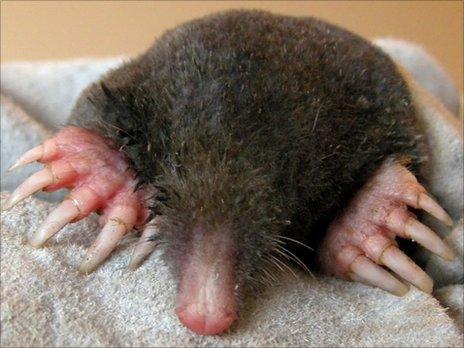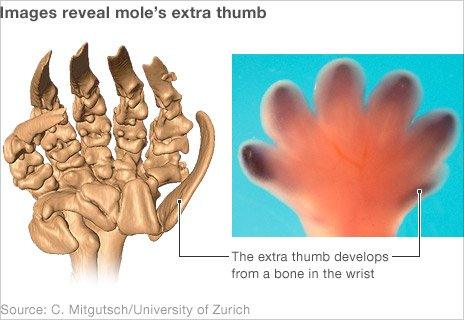Mystery of mole's second thumb solved
- Published

The extra digit plays a crucial role in mole digging proficiency
Scientists have discovered how one of the world's best diggers got its "extra thumb".
Comparing the mole's digits with those of its close relative, the researchers looked for molecular clues to the anatomical oddity.
The results show that the mole's second thumb is not a real digit but starts out as a wrist bone, the scientists report in Biology Letters., external
The extra appendage helps propel the mole through its subterranean world.
The very early four-legged land vertebrates, such as Acanthostega and Ichthyostega, that dragged themselves from the muddy waters on to land had five, six, seven, even eight fingers. But evolution seems to have favoured the five-fingered.
And so today, whether they have paws, claws or hands, most vertebrates have five digits. The exceptions, such as hoofed animals and birds have all descended from five-fingered ancestors.
In today's world, the giant panda and the mole are anomalies among vertebrates: both have a second thumb, giving them a total of 12 digits.
A fake
Their extra thumbs are considered adaptations to their modes of life.
The panda uses its thumbs to better grip its favourite bamboo food, while the mole's shovel-like claws are probably an adaptation to its dirt-filled tunnels.
Now new research suggests that the mole's second thumb, just like the Giant panda's, is a fake.
Developmental biologist Christian Mitgutsch, and his colleagues, from the University of Zurich, Switzerland, looked at the hands of eight mole species, and compared them with those of their close relative, the shrew.

By looking at the developing paws of the mole, Dr Mitgutsch was able to see that genes that usually turned on at the beginning of digit development did not show up when the mole's thumb started to form.
What is more, these cells did not start to extend into a finger-like protrusion until after the five other digits were well on their way to being fully formed.
Them wrist bones
However, what clinched it for Dr Mitgutsch was when he and his team showed that the second thumb seems to grow from tissue that usually develops into wrist bone, and not finger bone.
All of the eight mole species had some form of extra thumb, Dr Mitgutsch explained, but some did not develop past a small milimetre-long bone at the bottom of their paws, while others, like the Iberian mole, Talpa occidentalis, had a second thumb that matched the length of its five other fingers.
The researchers suspect that the mole's hormones are responsible for the six-finger quirkiness.
Female moles possess both ovararian and testicular tissue, and therefore have high levels of testosterone compared to species where individuals are either one sex or the other.
Exposure to high levels of testosterone - a known bone builder - in the uterus has been linked to polydactylism, a condition where people are born with extra fingers and toes.
However, there is more work to do before researchers can point the finger at testosterone when it comes to the mole's extra digits.
- Published8 February 2011